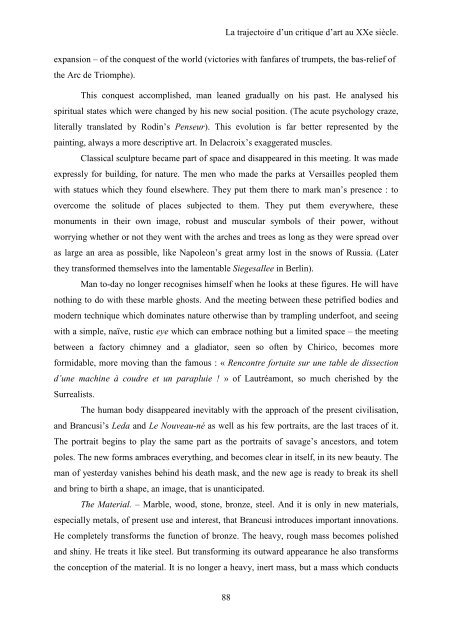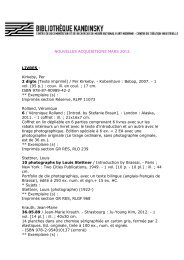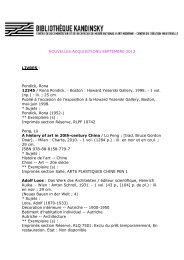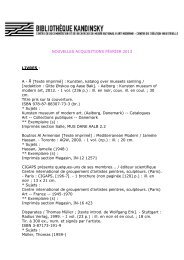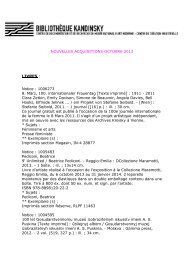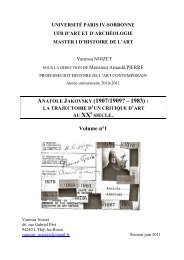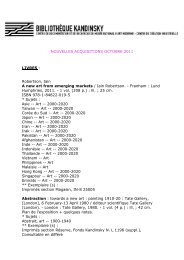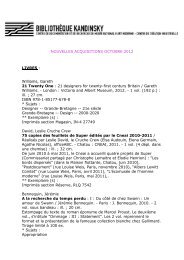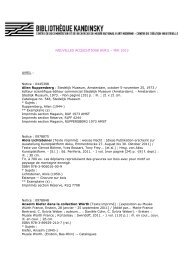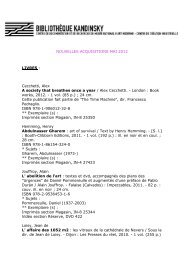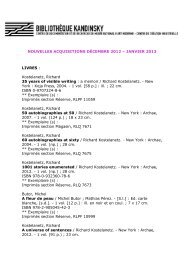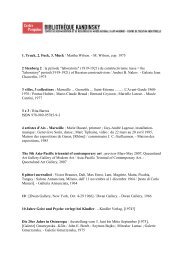anatole jakovsky (1907/1909 ? â 1983) - Bibliothèque Kandinsky
anatole jakovsky (1907/1909 ? â 1983) - Bibliothèque Kandinsky
anatole jakovsky (1907/1909 ? â 1983) - Bibliothèque Kandinsky
Create successful ePaper yourself
Turn your PDF publications into a flip-book with our unique Google optimized e-Paper software.
La trajectoire d’un critique d’art au XXe siècle.<br />
expansion – of the conquest of the world (victories with fanfares of trumpets, the bas-relief of<br />
the Arc de Triomphe).<br />
This conquest accomplished, man leaned gradually on his past. He analysed his<br />
spiritual states which were changed by his new social position. (The acute psychology craze,<br />
literally translated by Rodin’s Penseur). This evolution is far better represented by the<br />
painting, always a more descriptive art. In Delacroix’s exaggerated muscles.<br />
Classical sculpture became part of space and disappeared in this meeting. It was made<br />
expressly for building, for nature. The men who made the parks at Versailles peopled them<br />
with statues which they found elsewhere. They put them there to mark man’s presence : to<br />
overcome the solitude of places subjected to them. They put them everywhere, these<br />
monuments in their own image, robust and muscular symbols of their power, without<br />
worrying whether or not they went with the arches and trees as long as they were spread over<br />
as large an area as possible, like Napoleon’s great army lost in the snows of Russia. (Later<br />
they transformed themselves into the lamentable Siegesallee in Berlin).<br />
Man to-day no longer recognises himself when he looks at these figures. He will have<br />
nothing to do with these marble ghosts. And the meeting between these petrified bodies and<br />
modern technique which dominates nature otherwise than by trampling underfoot, and seeing<br />
with a simple, naïve, rustic eye which can embrace nothing but a limited space – the meeting<br />
between a factory chimney and a gladiator, seen so often by Chirico, becomes more<br />
formidable, more moving than the famous : « Rencontre fortuite sur une table de dissection<br />
d’une machine à coudre et un parapluie ! » of Lautréamont, so much cherished by the<br />
Surrealists.<br />
The human body disappeared inevitably with the approach of the present civilisation,<br />
and Brancusi’s Leda and Le Nouveau-né as well as his few portraits, are the last traces of it.<br />
The portrait begins to play the same part as the portraits of savage’s ancestors, and totem<br />
poles. The new forms ambraces everything, and becomes clear in itself, in its new beauty. The<br />
man of yesterday vanishes behind his death mask, and the new age is ready to break its shell<br />
and bring to birth a shape, an image, that is unanticipated.<br />
The Material. – Marble, wood, stone, bronze, steel. And it is only in new materials,<br />
especially metals, of present use and interest, that Brancusi introduces important innovations.<br />
He completely transforms the function of bronze. The heavy, rough mass becomes polished<br />
and shiny. He treats it like steel. But transforming its outward appearance he also transforms<br />
the conception of the material. It is no longer a heavy, inert mass, but a mass which conducts<br />
88


